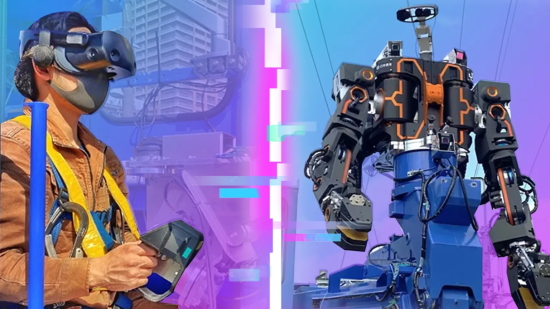[Two short articles from VRScout and New Atlas report on a new application of teleoperation technology by a major railroad company in Japan. See the original versions of both stories for more pictures; videos are available via Twitter and YouTube. For related news, see an International Railway Journal
story about the planned use of VR and digital twin technologies to maintain a new British high-speed rail line. –Matthew]

[From VRScout]
Giant VR Robots Are Building Railways In Japan
Could VR-powered humanoid robots be the future of heavy construction?
By Kyle Melnick
April 26, 2022
Over the years we’ve seen a number of major corporations try their hands at marrying VR technology and robotics, from VR convenience store employees and a remote-controlled bomb squad bot to a rather unsettling headset that uses a robotic arm to hand-feed delicious candy. And that’s just the tip of the proverbial iceberg.
Earlier this month, JR West—a major railroad transportation company operating out of Japan—revealed plans to use giant VR-powered robots in the construction of future railroad lines. The multifunctional railway heavy equipment is comprised of a railroad construction vehicle merged with a humanoid heavy robot, resulting in a sort of blue-collar Transformer.
First reported by Mynavi, the mechanical contraption was developed in collaboration with Nippon Signal, a railway signal technology company, as a way to increase productivity while improving workplace safety. According to JR West, VR-enabled robots will reduce on-site accidents, such as electric shock and crashes, by removing the need for direct human intervention.
The system is surprisingly straightforward. Operators sit in the driving cab and use an HP Reverb G2 VR headset to view the world from the perspective of the robot. A large control panel is used to operate two mechanical arms equipped with dual clamps, allowing users to interact with various machinery in detail. Operators will supposedly be able to feel the weight of objects as they work, offering a more intuitive and natural experience.
JR West is currently in the process of testing its heavy equipment robot before making the technology available for use in the Spring of 2024. While designed for railroad construction, it’s easy to how the system could be adapted to serve other practical use-cases throughout a variety of industries. The company’s VR robot could theoretically be used for operating on powerlines, demolition, roofing and high-rise work, and various other high-risk scenarios.
—
[From New Atlas]
Japanese rail company rolls out VR-piloted Gundam robot worker
By Loz Blain
April 27, 2022
The West Japan Rail Company has released video of its new humanoid heavy equipment robot. Mounted on the end of a crane, this gundam-style robot torso mimics the arm and head motions of a human pilot, who sees through the robot’s eyes via VR goggles.
The key objectives here, according to the company, are “to improve productivity and safety,” enabling workers to lift and naturally manipulate heavy equipment around the rail system without exposing them to the risk of electric shocks or falling.
The robot’s large torso is mounted to a hydraulic crane arm, which rides around the rail system on a specially braced rail car, putting down stabilizing legs when it’s time to get to work.
A human pilot puts on a set of VR goggles, which are motion-tracked to control the movements of a Wall-E-style head with stereo vision. Gripping a pair of handles, the pilot is able to move the robot’s arms and hands – and if an external force like a weight moves the robot’s arms, this motion is reflected back to the pilot’s controls.
A video released on Twitter shows the robot lifting and positioning some reasonably sizeable components, as well as cleaning overhead rail structures with a special multi-angle brush. It grips all these tools in what look like relatively simple clamp-like “hands,” showing a reasonable degree of dexterity, albeit operating at a fairly slow speed.
Typically, any attempt to make a robot look humanoid would make us think it probably doesn’t work as well as it could if it didn’t look humanoid. But in this case, it makes sense: the pilot can quickly gain a kinetic feel for operating the robot, since its arms and head are in familiar places relative to one another.
JR West is developing this machine in partnership with Human Machinery co. and Nippon Signal co.
|